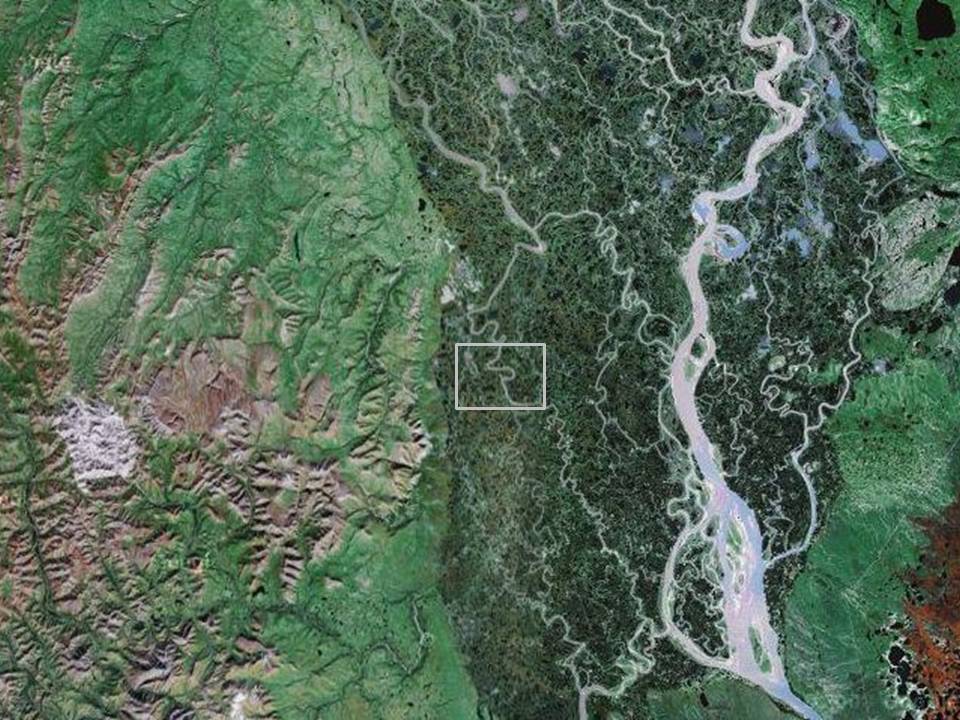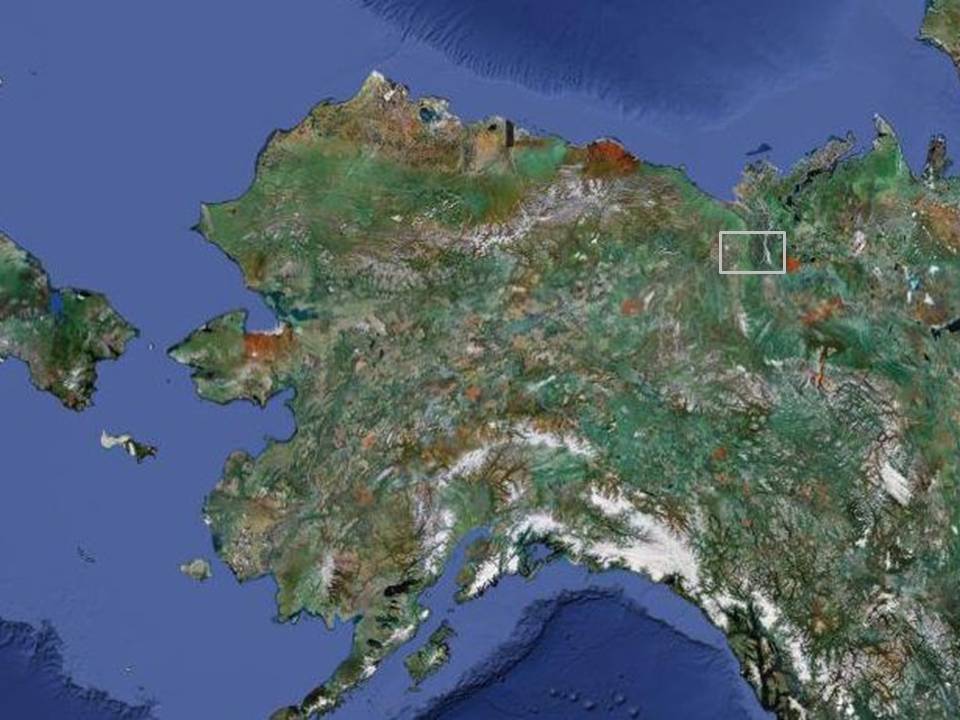 It’s not often we remember exactly where we were 10 years ago to the day. On this year’s summer solstice, however, the recall was easy. As we drifted toward the confluence of the Wind and Little Wind rivers, we met a familiar view of the low-lying Illtyd Mountains. On our first trip into the Wind River drainage in 2002, we hadn’t heard of a packraft but, similar to this visit, intended to hike in and paddle out. The concept was beautiful—we would go “ultra-light,” bringing only the tools necessary to build the canoe rather than the canoe itself. These tools included a bow saw blade, small axe, froe, drawknife blades, and pot for steaming roots. We spent 2 months hauling food and gear over the continental divide, building a bark canoe at the headwaters of the river (spruce as no birch were available), and, eventually, paddling the 300 miles to Fort McPherson. The enormous amount of food we carried in, though insufficient to meet our needs, made travel slow and cumbersome, forcing us to double carry. The bright idea, though ultimately executed, had us hanging by the skin of our teeth—short on food, short on time, and with little safety margin.
It’s not often we remember exactly where we were 10 years ago to the day. On this year’s summer solstice, however, the recall was easy. As we drifted toward the confluence of the Wind and Little Wind rivers, we met a familiar view of the low-lying Illtyd Mountains. On our first trip into the Wind River drainage in 2002, we hadn’t heard of a packraft but, similar to this visit, intended to hike in and paddle out. The concept was beautiful—we would go “ultra-light,” bringing only the tools necessary to build the canoe rather than the canoe itself. These tools included a bow saw blade, small axe, froe, drawknife blades, and pot for steaming roots. We spent 2 months hauling food and gear over the continental divide, building a bark canoe at the headwaters of the river (spruce as no birch were available), and, eventually, paddling the 300 miles to Fort McPherson. The enormous amount of food we carried in, though insufficient to meet our needs, made travel slow and cumbersome, forcing us to double carry. The bright idea, though ultimately executed, had us hanging by the skin of our teeth—short on food, short on time, and with little safety margin.
This time around, we employed a different strategy, moving fast and light, covering the same number of miles in 13 days rather than 60. The packrafts and their amazing portability—weighing in at under 8 lbs fully outfitted—made this feasible. Our route was different as well, hopscotching between floating and hiking, connecting adjacent river valleys.
From the Tombstone Mountains, we hiked into the West Hart River, passing alpine flowers in bloom, a lanky brown-black wolf, and several caribou. Nests housing the tiny eggs and downy chicks of Arctic Warblers, White-crowned Sparrows, and other breeding songbirds dotted the thickets of willows and alders. After 25 miles of walking we finally had enough water to begin bumping along and we happily left the mud and tussocks behind. Knowing almost nothing about the headwaters of the river, we were anxious to jump in but uncertain about what it might bring. The river became more exciting as we traveled downstream, encountering plenty of whitewater to keep us on our toes. Class III ledges and boulders followed mellow gravel bars, winding from colorful canyon walls to forested bluffs. A moose and her brand new calf swam the river just ahead of us. Mergansers and Harlequin Ducks bobbed along in the waves. Too soon we reached the confluence with the main Hart River where we loaded the boats onto our backs once again.
We waded across Waugh Creek’s crystal clear water many times, following game trails through willows and alder. The creek led us by deep pools beneath rock faces that later gave way to wide valleys with massive ice as thick as 6 ft deep, 1 mile long, and half a mile wide. Called “aufice,” or “glacier” by locals, it is formed by freezing from the “bottom up,” in which layer after layer of water (overflow) builds throughout the winter. Unlike the deep snow in the Tombstones, the ice provided good walking with a break from the bugs. Tussocks with swarms of mosquitoes and blazing sun slowed our progress, sending us search in vain for better terrain. Finally, on Forrest Creek, we gladly traded bushwhacking for cottongrass, then at last said enough and dropped our packs and inflated our rafts. We put in early and got hung up early, unable to outrun mosquitoes as we drifted along. The Little Wind brought plenty of water for our boats and at last we spilled into the Wind River, familiar ground to us. As the walls of the Peel Canyon rose around us, an an eerie “chreee” of a Red-tailed Hawk (in our minds-eye, perhaps the same bird we heard 10 years earlier) set the tone as we slid into a wave train. This time, with lower water levels and manufactured boats, we were relaxed. Last time, we found ourselves way out there, gripping whittled paddles, unsure of the breaking point of our canoe. Thinking back to summer solstice spent at our canoe-building camp on the upper Wind River—a couple of kids with an outrageous idea and a heap of optimism—our practicality on this go-around might almost be called boring. But, fortunately, things rarely go according to plan.
70 miles from Ft McPherson, as we choked on mosquitoes and smoke from forest fires burning all around us, we also remembered why we pulled 16 hour days in the canoe, paddling mile after mile along the sluggish river. But this time, speed was not on our side. Though the packrafts have made this trip possible, they can’t compete with the bark canoe in flatwater paddling. With a stiff headwind leaving us at a near standstill, one and then both of us retreated to the shoreline, stumbling downriver through mud and brush. Sinking up to our knees in the shoe-eating muck, at times we had to resort to a full crawl to extricate ourselves. Thunder and lightning storms raged, stirring up dust devils on the gravel bars and casting a dramatic hue to our misadventures. Morale waned a bit as what should have been an easy day of boating turned to two days of mud-bogging on empty bellies. Persistent aches and pains have been nagging as well—it’s often a blurry line between chronic discomfort (which is a given on a trip like this) and injury. This leg seemed to bring some of the highest highs and lowest lows yet, and the mud and mosquitoes incited the latter. There is a beauty in the rawness of a place like this, in which crossbills and goshawks thrive but humans suffer. But appreciating the scenery through a headnet takes a certain kind of grace and humility of which I find I’m only intermittently capable.
A box of cookies and quart of chocolate milk helped to lift our spirits as we made it to the joint store/post office/gas station in Ft McPherson. Since arriving here, we’ve already met several folks whose families have hunted, fished, and trapped in this area for generations, sharing stories about travel by dog team, canoe, and Skidoo. They also cautioned us about the vulnerability of the entire Peel River watershed to development pressures and ask that we help to bring awareness to these issues (ProtectPeel.ca).
As we head north toward the Arctic coast, we will leave the trees behind and enter the enormous web of the McKenzie River Delta. We have another 140 miles of boating (let’s hope that north wind goes easy on us!) and 90 miles of walking to reach Herschel Island. Internet and phone are hard to come by, so updates and photos may be a bit delayed but we’ll do our best to keep them coming. We’re thinking of you all, especially Kate & Nate and their new arrival! Thanks as always for the encouragement and emails—they mean a lot to us!



